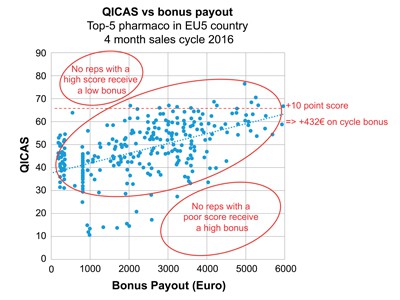
Spoiler alert: this is not just another article encouraging pharma to make better use of CRM (customer relationship management) tools. Instead, we’d like to share with you a dramatic and exciting discovery – evidence of a direct correlation between optimised CRM and improved business performance. And we’re going to hang some real numbers on it. In fact, the relationship between the two is so powerful, it’s reasonable to assume that any pharma company might benefit from such an approach.
In order to reap such rewards, it’s crucial to approach, implement and govern CRM in the right way. Transitioning from a good CRM to a great CRM demands setting up a CRM journey with a clear vision and objective that will help you move beyond deployment into operational efficiency and commercial effectiveness – eventually advancing to where CRM is positively impacting revenue, customer satisfaction and profitability.
There are three elements crucial to the success of the CRM journey: steering, enabling and measuring. In the deployment stage, ‘steering’ is the predominant theme. It’s about building the vision, defining business processes, and anchoring and revisiting governance.
Moving forward, the ‘enabling’ element plays an increasingly important role. This is really about focusing on the use of the tool itself, creating standards in methodologies and reporting, setting up training and driving change management.
The third element, ‘measuring’, is crucial across the entire journey. Diverse elements need to be measured at different stages. At the start of the journey, you will want to know the basics, such as if users are connecting and synchronising information.
Then, as you move into operational efficiency, you will want to see evidence that things are happening more promptly, such as reporting times, call entering, planning and information updating. This efficiency gain should transform the way life science commercial teams are working, so you will want to know if they are:
• Targeting the right customers and adhering to the call plan?
• Following the set strategy to achieve business objectives in a value-based selling environment?
• Making the right number of interactions at the right cadence and through the right channel?
• Able to influence and move the customer to the more favourable position?
By the time you move into the business optimisation stage, you will have fewer, better-equipped life science commercial teams having higher quality interactions with healthcare professionals, so you will be looking to measure revenues and the effects of channel mix, customer satisfaction, reduction in full-time employees due to automation, and so on.
A great CRM demands a clear vision and objective for operational efficiency and commercial effectiveness
To help companies benchmark the use and performance of their CRM, we developed a standard comparison metric, called the QuintilesIMS CRM Adoption Score (QICAS), in which we calculate a score between 0 and 100 based on multiple criteria – such as the number and duration of connections, number of iPad synchronisations, time to enter calls, number of modules used, basic modules vs advanced modules, etc.
The score can be recalculated at regular intervals (eg monthly, quarterly) for progress analysis, and can be used to compare results between clients, countries, teams, type of users, districts and individuals. So it’s possible to see where you have room for improvement at any of these levels and, therefore, where you may need to focus additional training and resources.

The score can also be cross-referenced with performance metrics. For that we used the bonus payments and QICAS for each sales representative in a specific market looking for correlation. Of course, this can only be valid if the incentive compensation model is accurate in linking reward to performance. In fact, we observed non-optimal incentive compensation models that confirmed our hypothesis.
We discovered a significant correlation between the QICAS and bonus payments of life science sales representatives of a top-five pharma company in an EU5 country. Firstly, no rep with a high score received a low bonus, and conversely, no rep with a low score received a high bonus. Secondly, we were able to deduce from this four-month sales cycle, that a 10-point gain in QICAS equates to an additional 432 euros in the pocket of the sales representative.
So it’s reasonable to infer that through an effective CRM journey, life science commercial teams will be motivated to use CRM, increasing revenue for the company and earning additional commission themselves. And in an environment where companies are increasingly being squeezed for greater performance, that’s a win-win situation.
Charlotte Pineau is global customer success director at QuintilesIMS
charlotte.pineau@quintilesims.com
Gilles Meunier is CRM director at QuintilesIMS
gilles.meunier@quintilesims.com





